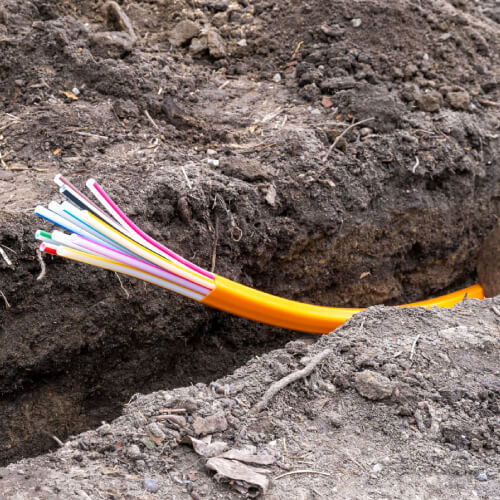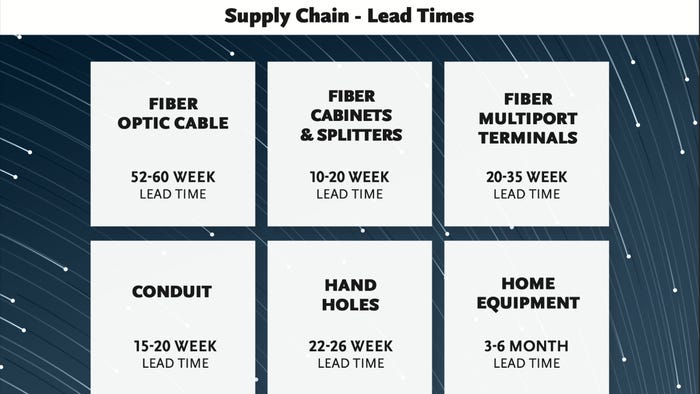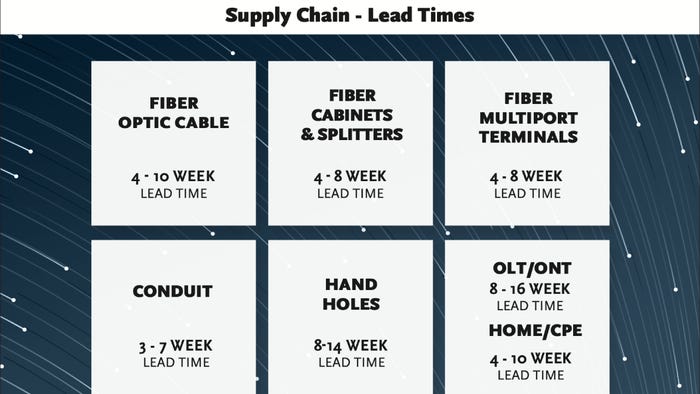Fiber industry sees shorter lead times for materials... for now
While supply chain lead times have come down significantly from last year, fiber execs are encouraging industry stakeholders to plan accordingly for BEAD bottlenecks.

Fiber industry executives expressed cautious confidence on a webinar this morning about the state of the fiber supply chain as compared to last year. But they also warned that lead times will lengthen as funding from the $42.5 billion Broadband Equity, Access and Deployment (BEAD) program starts rolling out next year.
The webinar, hosted by the Fiber Broadband Association (FBA) and led by members of its supply chain working group from Corning, OFS, Calix, Shentel and Graybar, followed the recent release of an updated white paper about the state of the fiber supply chain and mitigation strategies for bottlenecks. When the first version of the white paper was released in summer 2022, lead times for critical components without contractual commitments ranged from 15-20 weeks for conduit to 52-60 weeks for fiber-optic cable.
Figure 2:  Lead times for critical components with no contractual commitments, as of September 2022.
Lead times for critical components with no contractual commitments, as of September 2022.
(Source: Fiber Broadband Association)
Now, however, those bottlenecks have shortened to 3-7 weeks for conduit and 4-10 weeks for fiber, according to the white paper. Meanwhile, other materials like semiconductors and fiber pedestals still have longer lead times.
"We're still finding that several components remain at 42-50 weeks, even more in some cases," said Jerry Cederlund, SVP of customer supply and fulfillment operations at Calix.
Figure 3:  Lead times for components with no contractual commitments, as of March 2023.
Lead times for components with no contractual commitments, as of March 2023.
(Source: Fiber Broadband Association)
Members of the working group cautioned the industry not to get comfortable with shorter lead times, as BEAD dollars flowing to every state will increase demand for materials.
"The supply chain committee forecasts lead time will increase once funding is distributed, but not to 2022 levels we saw," said working group Chair Scott Jackson, national broadband market manager at Graybar. That's thanks in part to efforts made by companies like Corning and OFS, both represented on the webinar, which have invested in domestic fiber manufacturing.
"We've added about $500 million of investment to our capacity capability in order to help us supply fiber cable demand," said Corning's Joe Jensen, director of market development. This year, Corning announced new and forthcoming fiber manufacturing plants in North Carolina and Arizona.
Plan ahead
To mitigate anticipated supply bottlenecks in advance, the working group offered a series of tactics, including relationship building with suppliers, supplier diversification, building out capacity and "nearshoring," using smarter technology like AI for supply chain monitoring and – crucially – planning ahead.
The group pointed to advance planning as essential to preparing suppliers for project needs and ensuring there are contractors available to do the work.
"We all know the importance of forecasting in the material world, but we've been trying to do something very similar with our contractors – to let them know, 'Hey, here's what the roadmap of work looks like' ... so that they don't get the end of the project and move on to another company," said Jeff Manning, VP of operations at Shentel. "We try to provide them a pretty good funnel of activity to keep them engaged with our projects."
Buy America rules
The white paper comes as the federal government is revising rules for how it will apply "Buy America" provisions to BEAD as well as broadband grants funded through the American Rescue Plan.
Last month, as Broadband Breakfast reported, the NTIA published its long-awaited limited waiver on the $1 billion Middle Mile grant program, which it first proposed last year. In its final say on the matter, NTIA included routing and switching equipment, microwave backhaul, optical fiber transport equipment and undersea cable equipment in its waiver for Buy America rules, but it removed fiber optic cable noting there is enough domestic supply. Middle Mile grants are expected to be awarded this spring and summer.
How Buy America applies to the fiber-focused BEAD program remains to be seen. The Office of Management and Budget (OMB) is conducting a review and will issue further guidance, which will determine how NTIA defines limited waivers for BEAD. Many in the industry have already warned that Buy America rules will slow the program down.
Speaking on behalf of the FBA, Graybar's Jackson said the group submitted comments to OMB saying that there is enough optical fiber and cable in the US, but that other components "cannot be practically sourced from the US let alone in sufficient quantity at this time." Those include optical electronics, optical line and network terminals, fiber optic connectors, and fiber optic enclosures, he said.
Earlier this year, the NTIA noted that "manufacturers have time to re-shore or expand their operations" for BEAD but that it is "carefully monitoring administration-wide initiatives like the new proposed Made in America policies from the Office of Management and Budget (OMB) to ensure that we meet our obligations."
Related posts:
— Nicole Ferraro, editor, Light Reading, and host of "The Divide" on the Light Reading Podcast.
About the Author(s)
You May Also Like












